What is Persian Qanat? (System, History, Meaning)
Iran’s Qanats are one of the most interesting tourist attractions in the country. Thousands of years ago, Qanat or Kariz was created by Iranians for the first time as a solution to deal with dehydration. This simple but functional structure is a sign of the Iranian people’s intelligence and efforts to improve living conditions. Those interested in traveling in Iran can visit various aqueducts in every corner of this land, especially in the southern, eastern, and central provinces of Iran. In this article, we introduce the history and types of Iranian Qanats, how to dig Qanats and the oldest Qanats in the world in Iran.
What is Qanat?
A Qanat is an old underground water system used in dry places to get water from underground and take it to where it is needed.
It has different parts, like a deep well at the beginning to find water, a tunnel going underground, and canals on the surface to carry the water to farms and towns.
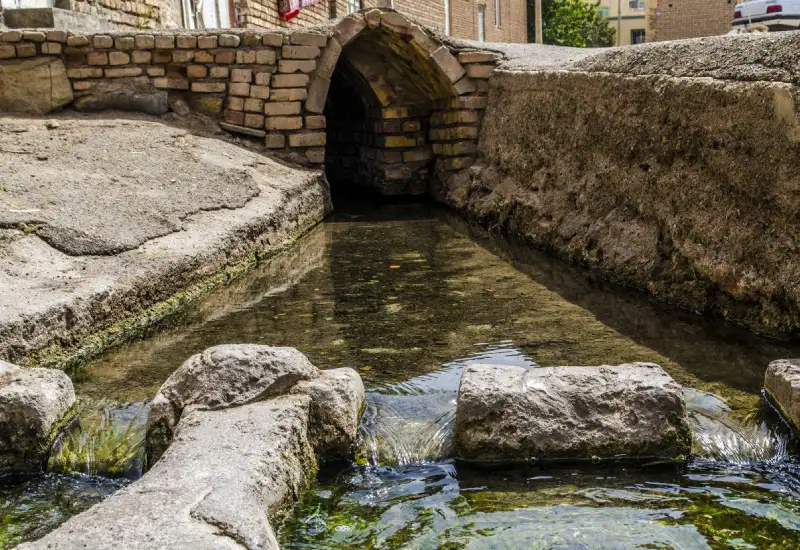
This system is clever because it helps save water and stops it from disappearing in the hot sun. People have been using Qanats for a very long time, especially in Iran, where they have helped cities grow and farms flourish in places with not much rain.
Today, Qanats are important for some areas, but they also face problems like less water in the ground and modern changes. Even though things have changed a lot, Qanats still remind us of the smart ways people found to get water and make life better in tough places.
They are part of the history and culture of many regions, showing us how people in the past worked together with nature to survive and thrive.
When was the Qanat System Invented?
In the early 1st millennium BCE, small groups and tribes began migrating to the Iranian Plateau, a region where the amount of rain was less than where they lived before.
These groups had a tradition of farming, which was made easier by the presence of rivers and plentiful water sources in their former locations.
However, upon settling in the Iranian Plateau, they faced a challenging environment with generally dry and arid conditions, and the overall rainfall was insufficient.
Ancient farmers attempted to dig channels and waterways during the rainy seasons, but these channels would often dry up during the summer. It was later discovered by these farmers that the water collected in tunnels within mining areas did not dry up.

Farmers made a deal with miners who were looking for copper metal, in which they asked the miners to build tunnels for them.
The farmers aimed to ensure that the water collected from various sources, forming small streams, would be sufficient for their agricultural needs and irrigation.
The farmers of ancient Iran, with the help of miners, were able to install a water management system to use Qanat water to irrigate their crops in the hot seasons of the year.
Based on archaeological research, the Qanat system innovation is believed to have originated in northwestern Iran, near the present-day border with Turkey.
Qanat Meaning
The word “Qanat” has its roots in Persian and is used to describe an ancient underground water system. In different regions, this term may have variations like “Kariz” or “Karez.”
In parts of Iran, Afghanistan, and the Middle East, “Kariz” is more commonly used, while “Qanat” is preferred in western Iran.
The term “Qanat” itself comes from the Persian word “kanat,” which is derived from the verb “kandan,” meaning “to dig” or “to create a channel.”
It is interesting to note that there are more than 27 names used for Qanats in various countries, highlighting the widespread use and adaptability of this creative water system.
Structure of the Persian Qanat
Every Qanat consists of one or more drainage channels, typically measuring around 1 to 1.4 meters in height and 50 to 60 centimeters in diameter.
These channels are accompanied by sturdy walls along their sides. Vertical ventilation shafts, which allow workers to access the Qanat, are connected to the drainage channel and eventually lead to the drainage canal’s end.
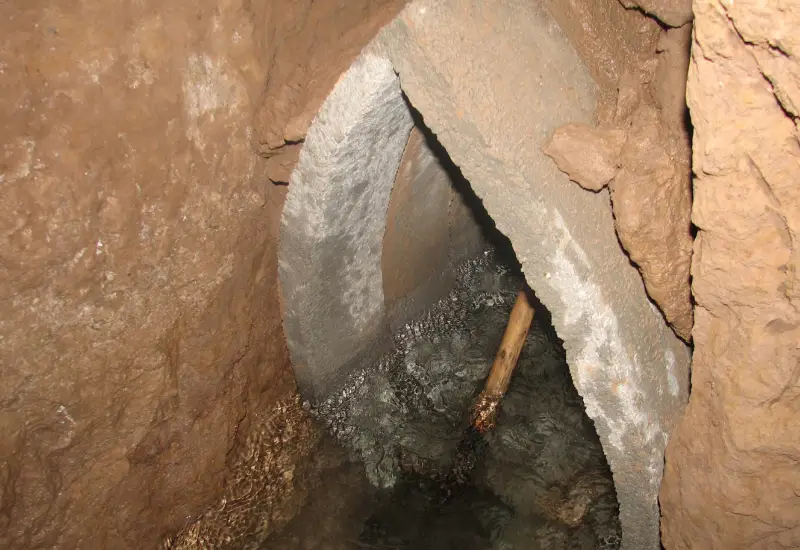
The length of the drainage channel can extend to several kilometers. In the late 17th and early 18th centuries, a French-British traveler named “Jean Chardin” wrote about this: “Iranians were not only capable of pinpointing the exact location of water but also had the ability to transport water over distances of up to 60 kilometers or sometimes even more.”
How to Dig a Qanat?
To create a Qanat in Iran, the process typically starts with digging a well or an entrance point. After excavating a certain portion of the entrance, initial shafts, which are essentially dry wells, are dug.
These shafts serve a crucial role not only in removing the debris from the digging process but also in facilitating airflow within the tunnel. Adequate airflow is essential to prevent the risk of suffocation for the workers. These shafts are evenly spaced along the tunnel.
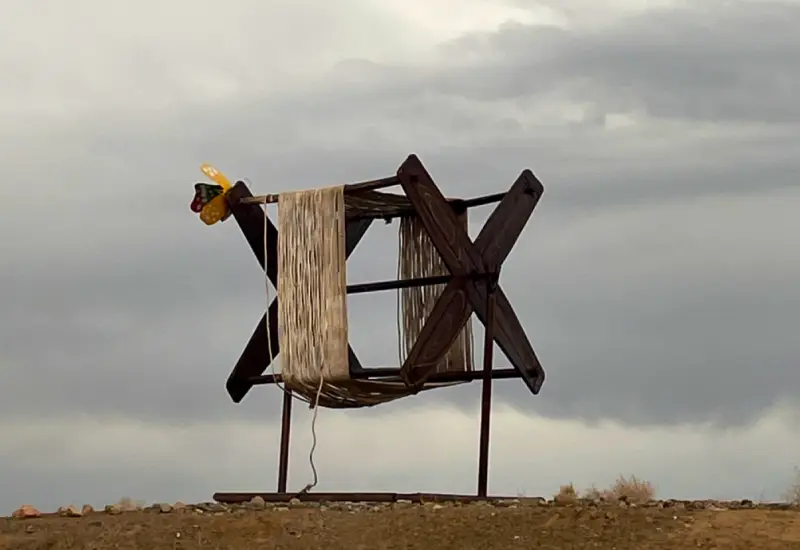
Then, the excavation of the tunnel continues until it reaches the Qanat’s outlet and the mother well. The tunnel’s gradient needs to be just right to ensure that water can flow easily through it towards the entrance.
Therefore, Qanats are often constructed in areas near mountains and foothills, where the natural terrain provides the necessary slope.
The tools and artifacts related to Qanat digging, along with the history of Qanats, can be explored at the historical Khaleh Dooz Museum, also known as the Yazd Water Museum.
The Oldest Qanat in the World
The Qanat-e-Qasabeh in Gonabad, Iran, holds the distinction of being the world’s oldest and, notably, one of the most water-rich Qanats, with a history spanning an impressive 2,500 years.
This remarkable feat of ancient engineering has a depth of 300 meters, making it the deepest mother well on the planet. Along its course, more than 470 ventilation shafts were strategically dug to prevent well blockages for various reasons.
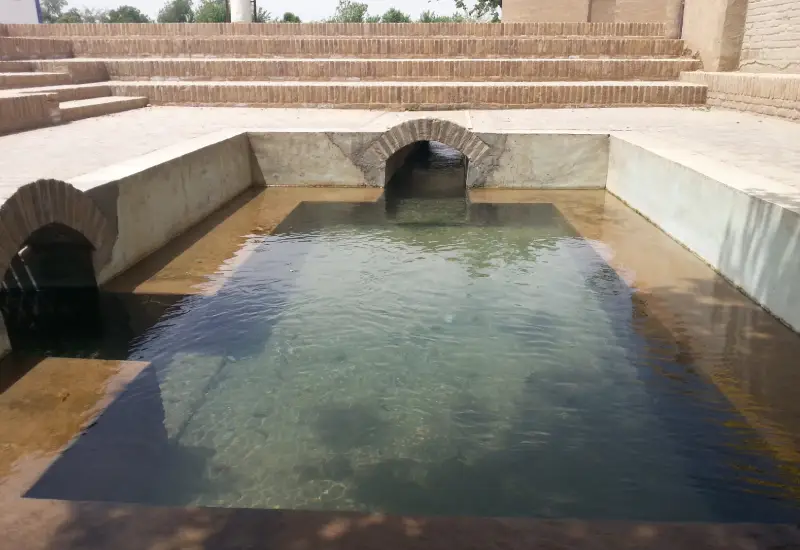
The Qanat-e-Qasabeh follows a winding and intricate path, featuring thousands of tunnels, each dark and enigmatic, showcasing the craftsmanship of the ancient Qanat builders.
Archaeological findings along the Qanat’s route trace its origins back to the Achaemenid era. In the distant past, Gonabad had no other Qanat or well to rely on, and the Qanat-e-Qasabeh stands as the same Kariz that has gifted life and prosperity to this modern city.
The Longest Qanat Iran
The Zarach Qanat in Yazd holds the title of the longest Qanat in Iran, stretching an impressive 120 kilometers and featuring a remarkable 2,115 well rings along its path.
This ancient Qanat, which is over 3,000 years old, was dug 23 meters deep into the earth’s surface and provided a reliable water supply up until about 150 years ago.
However, the extensive well digging along its course has significantly lowered the water levels within the Qanat. Global attention and efforts are now being directed towards revitalizing this historic waterway, which has the potential to once again flourish and serve the community.
The Baladeh Ferdows Qanat
The Qanat of Baladeh Ferdows, located in Ferdows, Iran, dates back to the Sasanian period. Although archaeological discoveries of pottery fragments around the Qanat suggest its history could reach back as far as 2,000 years ago.
This Qanat combines 15 Qanat branches and 4 springs to form a substantial water source. It serves as the lifeblood for villages such as Baghestan Bala and Payin, and Islamieh, rejuvenating 2,382 hectares of agricultural land and 1,800 orchards along its 35-kilometer route.
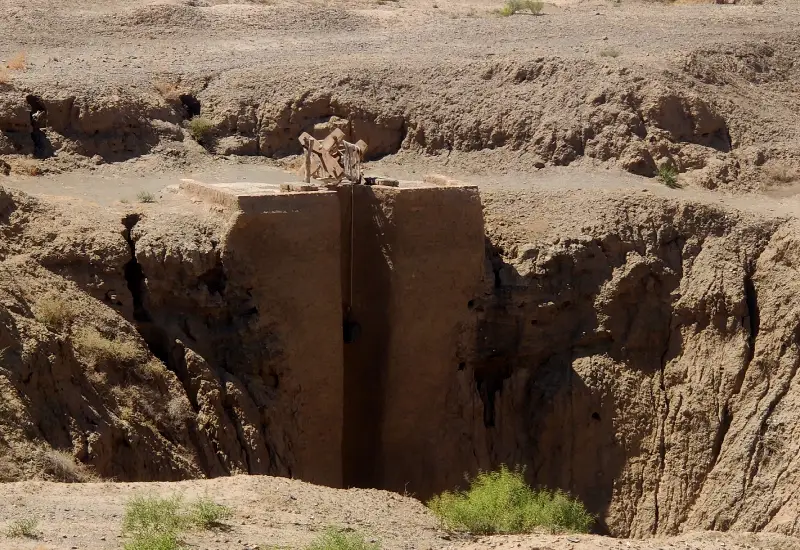
The Qanat of Baladeh Ferdows plays a crucial role in sustaining the local communities and their agricultural endeavors.
The Hasan Abad Qanat in Mehriz
The Hasan Abad Qanat in Yazd, Iran, belongs to the 8th century AD. What sets this Qanat apart is its shallow digging, and its unique feature is that it does not form gypsum and salt layers along its channel, ensuring that the water maintains its high quality throughout the way.
The water from this Qanat is used for various purposes, including storage in reservoirs, irrigating orchards and agricultural lands, and powering water mills.
Although today, the plentiful water from this Qanat is primarily used for the irrigation of orchards, highlighting its enduring importance in sustaining agriculture and the local fields.
Final Word
Ancient Iran Qanats, with their simple yet effective design, have not only irrigated dry lands but have also nourished the culture and heritage of Iran.
As they continue to provide a lifeline for communities in the country’s desert regions, Qanats also invite curious travelers to explore their depths and learn about the rich history and engineering marvels that lie beneath the surface.
In a world struggling with water scarcity and environmental challenges, Iranian Qanats serve as a timeless reminder that sometimes the solutions to our most pressing problems can be found deep in history.
Are you planning to travel to Iran and looking for an Iran resort? Consider Matinabad eco resort.





Leave a Reply
Want to join the discussion?Feel free to contribute!